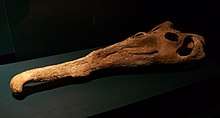Maurice Mehl
Maurice Goldsmith Mehl (born 1887 in Burlingame, Kansas, died in 1966 in Columbia, Missouri) was an American paleontologist. A longtime professor in the Department of Geology at the University of Missouri, Mehl was a founding member and officer of the American Association of Petroleum Geologists. Mehl was a fellow of the Geological Society of America (1922), the Paleontological Society, and the American Association for the Advancement of Science.
Maurice Goldsmith Mehl | |
|---|---|
| Born | 1887 |
| Died | 1966 (aged 78–79) |
| Nationality | American |
| Scientific career | |
| Fields | Paleontology |
| Institutions | University of Chicago University of Wisconsin University of Oklahoma Denison University University of Missouri |
Career

In 1922, he named Machaeroprosopus andersoni, on the basis of the holotype FMNH UC 396, partial skull. It was probably collected from the Bull Canyon Formation of the Chinle Group or Dockum Group, probably at the Bull Canyon, in the Guadalupe County of New Mexico. This taxon was considered to be a junior synonym of M. buceros by Long and Murry (1995) and later authors, although Stocker and Butler (2013) treated M. andersoni as a valid species. The holotype is the only known specimen of this species, although there are other specimens from the Bull Canyon Formation that were referred to Arribasuchus buceros by Long and Murry (1995), but not by Stocker and Butler (2013).
In 1929, he and Edward Branson described the Metoposauridae Koskinonodon.[1]
In 1930, he described Amphekepubis, a genus of mosasaur from the Late Cretaceous of Mexico. Their remains correspond to the holotype specimen UM VP 509 (University of Missouri), a partial skeleton preserved in three dimensions, comprising the pelvic area, hind limb bones and nine caudal vertebrae, found in the east of Monterrey, in the state of Nuevo Leon, which come from marine sediments (claystones) apparently from the San Felipe Formation, which corresponds to the boundary between the ages of Coniacian and Santonian in the early Late Cretaceous.[2] However, it has been suggested that age may be more recent and its remains even might belong to the genus Mosasaurus.[3][4]
In 1931, he erected the new ichnogenus Ignotornis for some bird tracks preserved in the Dakota Group near Golden, Colorado. These were the first scientifically documented Mesozoic bird footprints. The bird in question as interpreted as a "small shorebird or wader". The site would eventually be heavily collected and all of its tracks were presumed removed.
In 1932, he and Branson reported the presence of Carboniferous-aged fossil footprints of a new ichnospecies in the Tensleep Formation of Wyoming. They named the tracks Steganoposaurus belli and attributed them to an amphibian nearly three feet in length.
Also with Edward Branson, he named a new kind of Late Triassic dinosaur footprint discovered in the Popo Agie Formation of western Wyoming. The new ichnogenus and species was named Agialopus wyomingensis.
In 1933, he and Branson described the conodont Wurmiella excavata.
In 1934, with Branson, he described the conodont genera Pseudopolygnathus and Ancyrognathus.[5]
In 1936, he described the new ankylosaur species Nodosaurus coleii .[6]
In 1938, he and Branson reviewed the conodont genus Icriodus.[7]
In 1941, with Branson, he described the conodont genera Bactrognathus, Doliognathus, Scaliognathus and Staurognathus.[8][9]
In 1944, he described with Branson the conodont genus Siphonodella.[10]
References
- Mueller, B. D. (2007) Koskinonodon Branson and Mehl, 1929, a replacement name for the preoccupied temnospondyl Buettneria Case, 1922. Journal of Vertebrate Paleontology. 27 (1): 225.
- M. G. Mehl. 1930. A new genus of mosasaurs from Mexico, and notes on the pelvic girdle of Platecarpus. Denison University Bulletin, Journal of the Scientific Laboratories 29(10):383-400
- Marie-Céline Buchy, Eberhard Frey, Wolfgang Stinnesbeck, and José Guadalupe López-Oliva. Cranial anatomy of a Maastrichtian (Upper Cretaceous) mosasaur (Squamata, Mosasauridae) from north-east Mexico Archived 2012-06-30 at Archive.today. Revista Mexicana de Ciencias Geológicas, año/vol. 24, número 001. pp. 89-103
- Lingham-Soliar, T., 1995, Anatomy and functional morphology of the largest marine reptile known, Mosasaurus hoffmanni (Mosasauridae, Reptilia) from the Upper Cretaceous, Upper Maastrichtian of The Netherlands: Philosophical Transactions of the Royal Society of Geology of North America, Volume J, 205-215. London, B, 347, 155-180.
- Conodonts from Glassy Creek Shale of Missouri. EB Branson and MG Mehl, Univ. Missouri Studies, 1934
- Vickaryous, Maryanska, and Weishampel (2004); "Table 17.1: Ankylosauria", page 367.
- The Conodont Genus Icriodus and Its Stratigraphic Distribution. E. B. Branson and M. G. Mehl, Journal of Paleontology, Vol. 12, No. 2 (Mar., 1938), pages 156-166 (Stable URL retrieved 29 April 2016)
- New and Little Known Carboniferous Conodont Genera. E. B. Branson and M. G. Mehl, Journal of Paleontology, Vol. 15, No. 2 (Mar., 1941), pages 97-106 (Stable URL, retrieved 29 April 2015)
- Phylogeny of the Multielement Conodont Genera Bactrognathus, Doliognathus and Staurognathus. Karl M. Chauff, Journal of Paleontology, Vol. 59, No. 2 (Mar., 1985), pages 299-309 (Stable URL, retrieved 22 April 2016)
- Conodonts. EB Branson and MG Mehl, in HW Shimer and RR Shrock, Index Fossils of North America. 1944
- Mehl, Maurice; Toepelmann, W. C.; Schwartz, G. M. (1916). "New or little known reptiles from the Trias of Arizona and New Mexico with notes from the fossil bearing horizons near Wingate, New Mexico". University of Oklahoma Bulletin 103: 1–44
External links

- memorial (retrieved 23 April 2016)